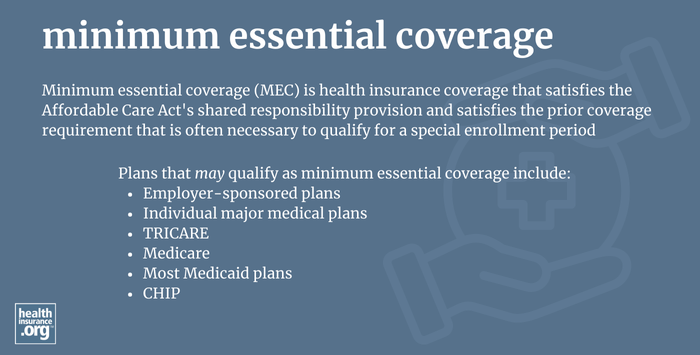
What is minimum essential coverage?
Minimum essential coverage (MEC) is health insurance coverage that satisfies the Affordable Care Act's shared responsibility provision (individual mandate).
Although there is no longer a federal penalty for not having minimum essential coverage, the individual mandate still exists.
And the concept of minimum essential coverage is still important, because several types of qualifying life events only trigger special enrollment periods if the person already had minimum essential coverage before the qualifying event.
And some states have imposed their own mandates, with penalties for residents who don't maintain minimum essential coverage.
What health plans are considered minimum essential coverage?
Plans that qualify as minimum essential coverage include employer-sponsored plans (including "skinny" employer-sponsored plans that don't provide minimum value), individual major medical plans (including new ACA-compliant plans, grandfathered plans, and grandmothered plans), TRICARE, Medicare, most Medicaid plans, and CHIP, among others.
Plans do not have to be compliant with the ACA to be considered MEC. Some plans that predate ACA implementation count as having coverage under the law, and employer-sponsored plans can offer very limited coverage and still count as minimum essential coverage.1
(Indeed, you might hear people referring to employer-sponsored limited benefit plans as "MEC plans" but that's just one subset of the type of coverage that counts as MEC.)
What plans are not considered minimum essential coverage?
For the most part, policies that are not major medical coverage and not regulated by the ACA do not count as minimum essential coverage (with the exception of employer-sponsored "skinny" plans, which do count as MEC even though they are not major medical coverage).1 So the list of plans that are not considered minimum essential coverage includes short-term health insurance, medical discount plans, limited-benefit plans, critical illness insurance, accident supplements, travel medical insurance, and dental/vision plans.
Indian Health Services coverage on its own is also not considered minimum essential coverage, although American Indians and Alaska Natives have access to year-round enrollment in the exchange (with zero-cost-sharing if income doesn't exceed 300% of the poverty level), and were exempt from the ACA's individual mandate penalty during the years that it was assessed.
Health care sharing ministries are also not considered minimum essential coverage, although their members were also eligible for an exemption from the ACA's individual mandate penalty.
Most Medicaid coverage is considered minimum essential coverage, but family planning Medicaid, tuberculosis-specific Medicaid, and emergency-only Medicaid are not. Pregnancy-related Medicaid and medically needy Medicaid may or may not be considered MEC, depending on the state.2
Do you need minimum essential coverage to qualify for a special enrollment period?
In many cases, yes. Quite a few qualifying life events will only trigger a special enrollment period if the person had minimum essential coverage before the qualifying event.
For example, marriage only triggers a special enrollment period if at least one spouse already had MEC prior to the marriage. So if they were both uninsured, or had coverage under something like a health care sharing ministry plan or short-term medical plan, the marriage will not give them a special enrollment period to buy ACA-compliant coverage.
However, there is an exception for people who have pregnancy Medicaid, CHIP unborn child, or Medically Needy Medicaid. These are not considered minimum essential coverage, but they do meet the prior coverage requirements when a person is enrolling in a health plan during a special enrollment period that requires prior minimum essential coverage.
So the end of coverage under pregnancy Medicaid, CHIP unborn child, and Medically Needy Medicaid will trigger a loss-of-coverage special enrollment period (for the mother as well as the baby, in the case of CHIP unborn child coverage).
What's the difference between minimum essential coverage and minimum value?
The terms minimum essential coverage and minimum value both stem from the ACA, and are sometimes conflated. But they mean two different things. Minimum essential coverage, as described above, is coverage that satisfies the ACA's individual mandate.
Minimum value, on the other hand, is a measure of whether a plan offered by an employer provides adequate coverage. To provide minimum value, an employer-sponsored plan must:3
- cover at least 60% of the average medical costs across a standard population of people covered by large group health plans (ie, similar to a bronze plan in the individual and small group market, although the calculations for actuarial value in the individual/small group market and minimum value in the large group market are not identical),4 AND
- provide "substantial coverage" for inpatient care and physician treatment.
Large group plans (in most states, "large group" means 51+ employees) do not have to cover the ACA's essential health benefits, and they do not have to fall into one of the ACA's metal level ranges. The minimum value provision is instead used as the basic requirement that large employer plans must meet or exceed to avoid penalties.
A large employer's plan has to be both affordable and provide minimum value. If it's not, and at least one employee obtains subsidized coverage in the exchange instead of enrolling in the employer's plan, the employer will be on the hook for the ACA's employer mandate penalty.
If an employee (working for an employer of any size) is offered employer-sponsored health insurance that either isn't considered affordable or doesn't provide minimum value, the employee can reject the coverage offer and apply for Marketplace subsidies instead (eligibility for Marketplace subsidies will depend on household income).
Some employer-sponsored plans provide minimum essential coverage but are actually skimpy plans
Large employers are subject to the ACA's employer mandate, which requires them to offer coverage to their full-time employees. The penalty for non-compliance is still in effect – only the individual mandate penalty was repealed. But there are two different penalty types under the employer mandate:
- One is for employers that simply don't offer coverage to at least 95% of their full-time employees. In 2025, this penalty is calculated as $2,900 per full-time employee (minus the first 30 employees), and it's triggered if even one full-time employee qualifies for a premium subsidy in the exchange.5
- The other is for employers that do offer coverage, but it's either unaffordable or does not provide minimum value (which would be the case if the coverage is a "skinny" plan, sometimes referred to as an "MEC plan"). The penalty in this case is the lesser of $4,350 per full-time employee receiving a Marketplace subsidy,5 or $2,900 per full-time employee minus the first 30 employees.
- Unaffordable, in 2025, is defined as the employee's share of the premium (for self-only coverage on the least-expensive plan the employer offers) being more than 9.02% of the employee's household income6 (note that this is an increase from 2024, when the affordability limit was 8.39% of household income.7)
- Minimum value, as noted above, is defined as covering at least 60% of costs for a standard population and providing "substantial coverage" for inpatient and physician care.
Depending on how many employees a company has, and how many of them end up seeking coverage in the exchange, the penalty can end up being significantly smaller if the employer offers coverage that doesn't provide minimum value and/or that isn't affordable for the employees (as opposed to not offering coverage at all).
Employer-sponsored coverage is, by default, considered minimum essential coverage. Fully insured (non-self-insured) small group health plans effective in 2014 or later are fully compliant with the ACA. But the waters can be murkier for large group plans and self-insured plans. Most of them are robust, offering solid coverage that often exceeds the level of coverage people tend to purchase in the individual market.
But some large employers opt for skimpy plans that do not provide minimum value, knowing that they can dodge the (potentially larger) penalty they'd incur if they didn't offer coverage at all.
Employees who are offered these plans don't always realize that the coverage is skimpy, and may not realize they're eligible for a premium subsidy in the exchange (and if an employer's coverage drops below the minimum value and/or affordability requirements mid-year, covered employees are eligible for a special enrollment period during which they can enroll in a plan through the exchange, with subsidies if they're eligible based on income).
Footnotes
- Minimum Essential Coverage (MEC) / Skinny Plans. Benefit Comply. January 2020. ⤶ ⤶
- Minimum Essential Coverage. Medicaid.gov. Accessed December 2023. ⤶
- Minimum Value. HealthCare.gov Glossary. Accessed December 2023. ⤶
- Minimum Value and Actuarial Value Determinations Under the Affordable Care Act. American Academy of Actuaries. April 2014. ⤶
- "Revenue Procedure 2024-14" Internal Revenue Service. Accessed Nov. 13, 2024 ⤶ ⤶
- “Revenue Procedure 2024-35”. Internal Revenue Service. Accessed Oct. 28, 2024. ⤶
- Revenue Procedure 2023-29. Internal Revenue Service. Accessed December 2023. ⤶


